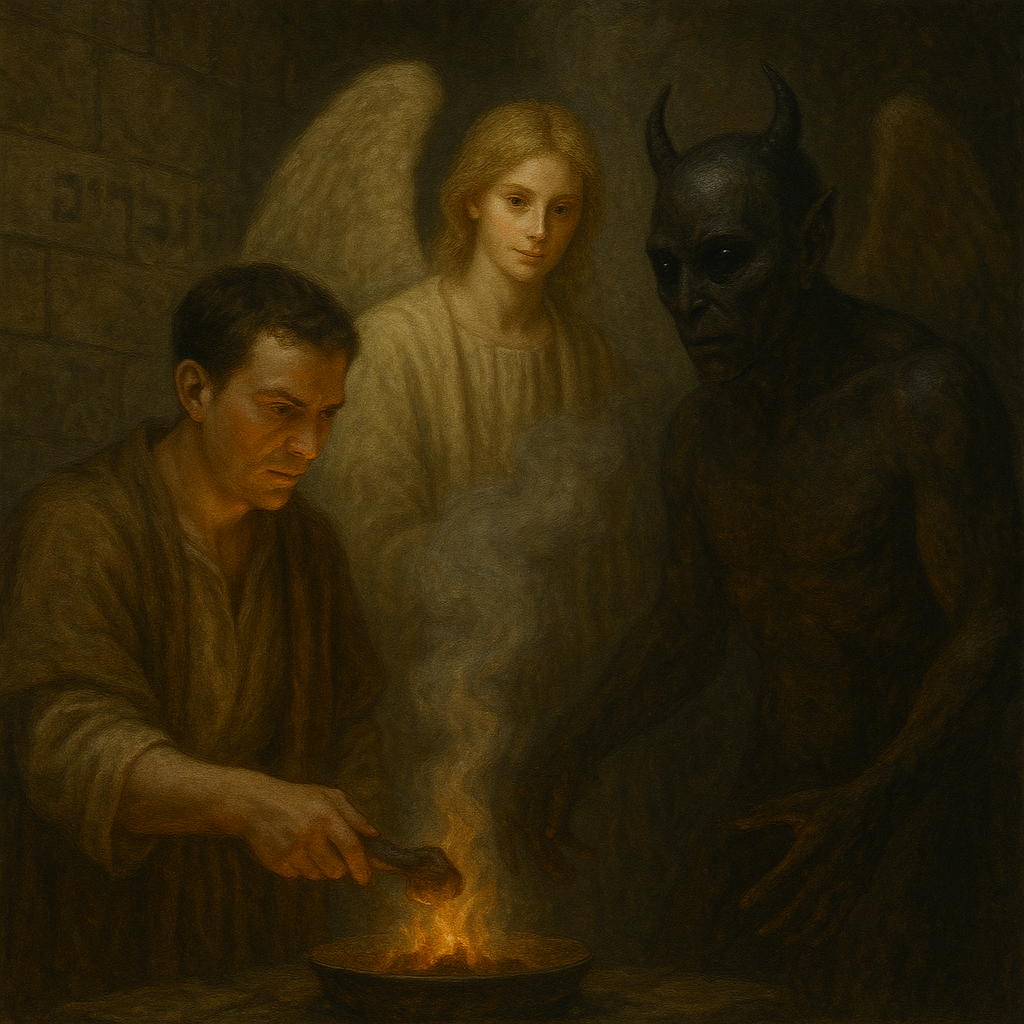Asmodeus: Demon Banishing

Asmodeus is depicted as a wicked demon, responsible for the deaths of Sarah’s suitors out of jealousy and malice. He is not a random spirit but a specific, named entity whose defeat is essential to the story’s resolution. This portrayal makes Asmodeus one of the very few demons mentioned by name in ancient biblical writings. It is not a formal exorcism prayer but rather a ritual action accompanied by a prayer, one of the rare instances resembling an exorcism in biblical literature.
Sarah is a central figure in the Book of Tobit, known for her tragic story. She was a young woman from Ecbatana who had been married seven times, but each of her husbands was killed on their wedding night by the demon Asmodeus before the marriages could be consummated. Her suffering became so great that she prayed for death, feeling cursed and abandoned. Sarah’s plight becomes pivotal because it sets up the story’s resolution: Tobias, guided by the archangel Raphael, is sent to her, and through divine intervention and ritual, he defeats Asmodeus and marries her. Sarah’s story highlights themes of perseverance, faith, and divine rescue, making her struggle and eventual deliverance significant to the overall narrative of demon-banishing and spiritual victory.
The Book of Tobit, included in Catholic and Orthodox Bibles but moved to the Apocrypha in Protestant versions, introduces Asmodeus, a demon who killed the first seven husbands of a woman named Sarah. Guided by the archangel Raphael, Tobias prepares to marry Sarah and performs a ritual by burning the heart and liver of a fish on hot coals. The smoke drives Asmodeus away. Following the ritual, Tobias and Sarah pray for God’s mercy and protection.
Across early English Bibles, Asmodeus in Tobit remains the only demon given a personal name. Figures such as Satan, Beelzebub, and Legion are mentioned, but these are titles, not personal names. Asmodeus stands as a distinct figure in the Bible and later became more prominent in Jewish and Christian folklore, often portrayed as a demon of lust and revenge. In Tobit, his role is more specific, acting out of jealousy to prevent Sarah from finding happiness.
Wycliffe’s Bible (1382), translated from the Latin Vulgate, refers to demons as fiends and translates Asmodeus as a fiend. Tyndale’s Bible (1526), the first English Bible from original Greek and Hebrew, excludes Tobit entirely, rejecting it as Apocrypha. The Geneva Bible (1560) uses the word devil and places Tobit in the Apocrypha section. The King James Bible (1611) translates demons as evil spirits and includes Tobit in the Apocrypha, though later editions often omitted it. Wycliffe employed Middle English heavily, with fiend being the term for demon. Geneva and King James shifted to more recognizable terms like devil and evil spirit.
When the Bible is examined closely, particularly the early English versions, the depiction of demon-banishing is notably different from later traditions. There are no formal demon-banishing prayers in the Bible. When Jesus and his apostles encountered demons in the New Testament, they issued commands rather than prayers. Mark 1:25 states, “Be quiet! Come out of him!” and Acts 16:18 notes, “I command you in the name of Jesus Christ to come out of her.” There is no chanting, no elaborate ceremony, only direct authority.
The Book of Enoch, an ancient Jewish text written between 300 and 100 BC, provides an extensive account of demonology. It was not included in the standard Bible except by the Ethiopian Orthodox Church. In Enoch, the Watchers, a group of fallen angels, mate with human women. Their offspring, the Nephilim, are monstrous giants. Upon death, their spirits remain as evil spirits or demons that inhabit the Earth.
1 Enoch 15:8-9 states, “The giants, who are born from the union of spirits and flesh, shall be called evil spirits upon the earth.” Azazel, another fallen angel, is credited with introducing warfare, magic, cosmetics, and forbidden knowledge to humans.
By the time of Enoch’s writing, Jewish culture had absorbed Babylonian, Persian, and Greek influences. Apocalyptic literature like Enoch focused on revealing heavenly secrets and addressing why evil exists. The Bible concentrated on covenants and laws, while Enoch delved into cosmic warfare and spiritual rebellion.
While the Bible offers little in terms of structured demon-banishing prayers, the story of Tobias and Asmodeus illustrates an ancient combination of ritual and prayer. The Book of Enoch, though outside the canon, explores the supernatural realm extensively, offering one of the first detailed origin stories for demons.
Later Christian traditions, particularly in the medieval period, expanded on these early ideas, developing elaborate exorcism rites. In modern times, the Catholic Church maintains a structured process for exorcism, as illustrated by Vatican-trained exorcists who emphasize thorough psychological and medical evaluations before proceeding with the rite. This careful approach reflects an understanding that not all cases of perceived possession are spiritual in nature.
Beliefs in demonic possession and exorcism are not limited to Christianity. Various religious traditions, including Islam and Hinduism, have developed their own methods of expelling malevolent spirits. This demonstrates the widespread human concern with unseen forces and the diverse ways cultures attempt to confront them.
Contemporary scientific perspectives suggest that phenomena traditionally attributed to possession may instead result from psychological or neurological conditions such as schizophrenia or dissociative identity disorder. Recognizing these possibilities ensures a balanced approach to understanding and addressing claims of possession.
Expanding beyond traditional interpretations, some modern theories suggest the existence of interdimensional entities, often described as reptilian beings, that attach to the human energy field, particularly through the chakra system. These entities are believed to feed off emotional energy, influencing human behavior by attaching to the root and sacral chakras, areas associated with survival and emotion. Such concepts reflect ancient concerns in a new framework, connecting with historical beliefs about malevolent spiritual influence.
Historical and cross-cultural traditions have long described serpent-like beings with manipulative powers, from the Nāgas in Hindu mythology to the Archons in Gnostic texts. Even the serpent in the Genesis narrative has been interpreted by some as a symbolic representation of deeper spiritual interference.
Some individuals experiencing altered states of consciousness, such as during deep meditation or astral projection, suggest that these interdimensional attachments may be perceived in non-ordinary states of awareness. These experiences parallel ancient shamanic practices where spiritual practitioners sought to diagnose and remove malevolent influences.
Adding to the complexity, the phrase “mystery of iniquity” originates from 2 Thessalonians 2:7 in the New Testament, where it describes hidden forces of lawlessness already at work in the world. The text suggests a secret power of wickedness that operates behind the scenes, paving the way for greater manifestations of evil. This idea has been expanded in modern interpretations to describe the hidden forces promoting moral decay and accelerating societal chaos. Father Malachi Martin, a former Jesuit priest and author known for his work on exorcism and spiritual warfare, introduced the idea of “perfect possession,” wherein individuals fully align with demonic forces, often remaining undetected due to their seemingly respectable social positions. In his view, these individuals have wholly embraced malevolent influences, rendering intervention ineffective.
Martin further warned of demonic infiltration within religious institutions, including the Vatican itself. He suggested that malevolent forces may exert influence even in sacred spaces, intensifying the spiritual crisis within the Church. These insights extend ancient concerns about spiritual warfare into modern institutional settings, reflecting a broader view of how unseen forces could impact not just individuals but entire organizations.
This view holds that the turmoil seen on Earth—violence, division, and unrest—mirrors a greater struggle in the skies above. Acts of compassion and unity are seen as echoes of the divine, while chaos and fear are attributed to malevolent influences.
In this context, divine forces are often described as beings such as Pleiadians, Tall Whites, Angels, or Atlanteans, acting as protectors or guides for humanity. In contrast, demonic forces are portrayed as entities thriving on discord and fear. These interpretations align with various religious and cultural narratives that personify good and evil through distinct entities.
The earliest narratives suggest that authority, rather than ritual, was the decisive force in confronting demons, a principle that continues to inform both spiritual and clinical approaches to dealing with the unknown.
Rituals aimed at false gods and demons were considered gateways or invitations for demonic activity, whereas holy ritual, such as Tobias burning the fish heart and liver, functioned as a method of banishment rather than attraction.
The concept that divine and demonic forces can manifest as aerial phenomena offers a contemporary perspective on ancient spiritual warfare. Historical accounts like Ezekiel’s vision of “wheels within wheels” are viewed as ancient reflections of celestial struggles. Modern interpretations of unexplained aerial phenomena, often termed “drones,” suggest a continuity between past and present understandings of divine and malevolent manifestations. This enduring narrative bridges millennia of human attempts to interpret signs of the unseen, reinforcing the idea that spiritual battles transcend time and cultural shifts.
In reflecting on these ancient and modern interpretations, it becomes clear that the struggle against unseen forces has been a timeless concern, evolving in form but constant in its presence. Whether depicted through ancient texts, mystical traditions, or modern theories, the battle between divine authority and malevolent influence continues to shape humanity’s understanding of good and evil.

